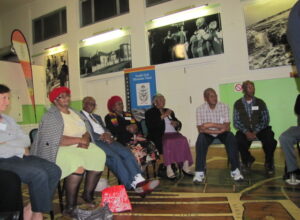One Community - Many Communities
The one community many community projects set out to document accounts of the affect the group areas act had on the people of the Northern Areas. The project set out to record an oral history of those forcibly removed and relocated to the northern Areas and to produce a documentary of the forced removals to the Northern Areas
During the 1960s, 1970s and early 1980s, the government of the time implemented a policy of 'resettlement', to force people to move to their designated "group areas". Some argue that over three and a half million people were forced to resettle during this period. These removals included people re-located due to slum clearance programmes, labour tenants on white-owned farms, the inhabitants of the so-called 'black spots', areas of black-owned land surrounded by white farms, the families of workers living in townships close to the homelands, and 'surplus people' from urban areas, including thousands of people from the Western Cape (which was declared a 'Coloured Labour Preference Area'[14]) who were moved to the Transkei and Ciskei homelands. The best-publicised forced removals of the 1950s occurred in Johannesburg, when 60,000 people were moved to the new township of Soweto, an acronym for South Western Townships.
The group areas act of 1950 played a major role in the destruction of communities such as South end, Fairview, Willow-dene, Korsten and Salisbury Park among many others. Most of the people living in these communities were moved to the what eventual became known as the Northern Areas.
This book is based on interviews conducted with individuals who were affected by the group areas act. It documents their story and culminates in a final chapter that focuses on the way in which the participants gained some form of closure.
The book is based on, and compliments the video documentary called One Community Many communities.
Press release
“Moving forward does not come easy, but it is essential in the process of nation building.”
– One Community-Many Communities (2013)
On Saturday 31st August 2013 the Southern Africa Development, Research, and Training (SADRAT) Institute will launch the One Community-Many Communities Project Finalé at the South End Museum at 14h30: the One Community-Many Communities Book in which individual stories of those who suffered under the Group Areas Act of 1950 is recorded; the One Community-Many Communities Video Documentary that captures the entire process, and the One Community-Many Communities Art Exhibition that takes its audience on a journey from the past to a better tomorrow.
The One Community-Many Communities project, funded by the National Heritage Council of South Africa (NHCSA), and facilitated by the Southern Africa Development, Research, and Training (SADRAT) Institute, carefully selected individuals and families across the Nelson Mandela Bay who had been affected by the Group Areas Act of 1950. These individuals all have one thing in common: they were forcibly removed from their homes in areas such as South End, North End, Korsten, Salisbury Park, Fairview and Willowdene under the creed of this ruthless Act.
A team of researchers from the SADRAT Institute conducted interviews with each of these individuals. The interviews provided a platform for them to share their untold stories; stories of how everything they had worked and lived for was lost: their skin colour was just not right.
“The project gave ordinary folks the opportunity to tell their story about the forced removals and the impact it had on their lives,” the managing director of the Institute, Gerhard Lück, said. “By telling their story in a safe and supportive environment, guided by professionals, they experienced some form of healing and closure.”
Lück also said that the documentary, book and exhibition will provide educational resources for the educational sector, the broader community and the immediate affected families. “The stories give people who have not experienced the trauma of the forced removals of the time some insight into the affect it had on the ordinary persons in South Africa. But more so, we believe that projects such as this are necessary tools in the process of healing the nation from the injustices of the past.”








